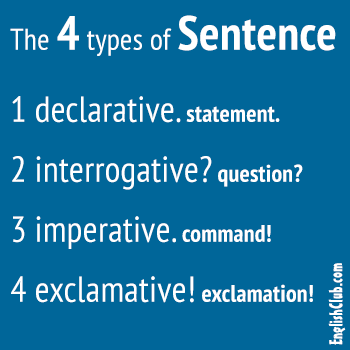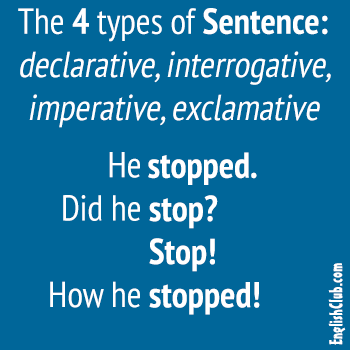(Do not confuse with the 4 types of sentence structure.)
There are four types of English sentence, classified by their purpose:
- declarative sentence (statement)
- interrogative sentence (question)
- imperative sentence (command)
- exclamative sentence (exclamation)

Sentence types are sometimes called clause types.
| form | function | example sentence (clause) | final punctuation | |
|---|---|---|---|---|
| 1 | declarative | statement: It tells us something | John likes Mary. | . |
| 2 | interrogative | question: It asks us something | Does Mary like John? | ? |
| 3 | imperative | command: It tells us to do something | Stop! Close the door. | ! or . |
| 4 | exclamative | exclamation: It expresses surprise | What a funny story he told us! | ! |
(form = structure / function = job)
1. Declarative Sentence (statement)
Declarative sentences make a statement. They tell us something. They give us information, and they normally end with a full-stop/period.
The usual word order for the declarative sentence is:
- subject + verb...
Declarative sentences can be positive or negative. Look at these examples:
| positive | negative |
|---|---|
| I like coffee. | I do not like coffee. |
| We watched TV last night. | We did not watch TV last night. |
Declarative sentences are the most common type of sentence.
2. Interrogative Sentence (question)
Interrogative sentences ask a question. They ask us something. They want information, and they always end with a question mark.
The usual word order for the interrogative sentence is:
- (wh-word +) auxiliary + subject + verb...
Interrogative sentences can be positive or negative. Look at these examples:
| positive | negative |
|---|---|
| Do you like coffee? | Don't you like coffee? |
| Why did you go? | Why didn't you go? |
3. Imperative Sentence (command)
Imperative sentences give a command. They tell us to do something, and they end with a full-stop/period (.) or exclamation mark/point (!).
The usual word order for the imperative sentence is:
- base verb...
Note that there is usually no subject—because the subject is understood, it is YOU.
Imperative sentences can be positive or negative. Look at these examples:
| positive | negative |
|---|---|
| Stop! | Do not stop! |
| Give her coffee. | Don't give her coffee. |
4. Exclamative Sentence (exclamation)
Exclamative sentences express strong emotion/surprise—an exclamation—and they always end with an exclamation mark/point (!).
The usual word order for the exclamative sentence is:
- What (+ adjective) + noun + subject + verb
- How (+ adjective/adverb) + subject + verb
Look at these examples:
- What a liar he is!
- What an exciting movie it was!
- How he lied!
- How exciting the movie was!

Note the form and function of the above four types. In general, we use the declarative form to make a statement. We use the interrogative form to ask a question. We use the imperative form to issue a command. We use the exclamative form to make an exclamation.
But function and form do not always coincide, especially with a change in intonation. For example, we can use the declarative form to give a command—You will now start the exam. Or we can use the interrogative form to make an exclamation—Wow, can Jo play the piano! We can even ask a question with the declarative form—Bangkok is in Thailand? So it is important to recognize this and not be confused when the function does not always match the form.
https://www.englishclub.com/grammar/sentence/type.htm
https://www.englishclub.com/grammar/sentence/type.htm
Tidak ada komentar:
Posting Komentar